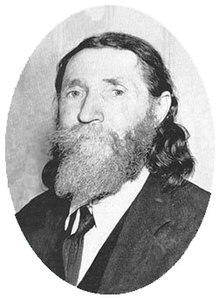| Revision as of 22:12, 9 June 2006 editRichhoncho (talk | contribs)Autopatrolled, Extended confirmed users, Pending changes reviewers347,649 editsm Disambiguation. You can help!← Previous edit | Revision as of 00:35, 23 June 2006 edit undo132.241.246.111 (talk) →See alsoNext edit → | ||
| Line 17: | Line 17: | ||
| == See also == | == See also == | ||
| *] for other pre Wright brothers inventors | *] for other pre Wright brothers inventors | ||
| *] | |||
| == External links == | == External links == | ||
Revision as of 00:35, 23 June 2006

Lyman Wiswell Gilmore, (June 11, 1874 – February 18, 1951), was an aviation pioneer. In Grass Valley, California, USA, he built a steam powered airplane and claimed that he flew it on May 15, 1902. Due to the requirement of a heavy boiler and the dependency on coal as a power source the flights would have only been short. Potential proofs of his claim was lost in a 1935 hangar fire. If his claims were true, the secret of his particular steam engine are lost to history, as no successful steam engine with a high enough power to weight ratio to effectively power an aircraft has ever been discovered since.
An eccentric man some people who remember him claim that he stank to high heaven, vowed to never cut his hair or beard and wore a trench coat even in the middle of summer. The coat contained not only all of his papers but two pistols.
Any remaining proof he beat the Wright Brothers was lost when he was forcefully deprived of his trench coat for a delousing and it was subsequently burned along with all the papers he carried in it.
There are photographs from 1898 showing Gilmore's machine, but none showing it in the air. He was in contact with other flight pioneers like Samuel Langley and eventually the Wright Brothers. In 1902, Gilmore was granted two patents on steam engines, the first of which was granted in 1902. He invented in other areas too, for example a rotary snowplow. On March 15, 1907 Gilmore opened the first commercial airfield, Gilmore Airfield.
After the fire in his hangar Gilmore began mining for gold and died a poor man in Nevada City.
See also
- Early flight for other pre Wright brothers inventors
- Mystery airship
External links
- http://www.ncngrrmuseum.org/
- http://www.flyingmachines.org/gilmore.html
- http://www.google.com/search?hl=en&lr=&as_qdr=all&q=%22LYMAN+GILMORE%22+site%3Ahttp%3A%2F%2Fwww.genealogyimagesofhistory.com